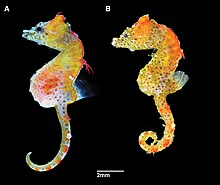Japanese pygmy seahorse
Species of fish From Wikipedia, the free encyclopedia
The Japanese pygmy seahorse (Hippocampus japapigu) is a Japanese species of seahorse in the family Syngnathidae.[2] It is also sometimes known as the Japan pig.[3]
| Japanese pygmy seahorse | |
|---|---|
 | |
| A is the male; B is the female. | |
| Scientific classification | |
| Domain: | Eukaryota |
| Kingdom: | Animalia |
| Phylum: | Chordata |
| Class: | Actinopterygii |
| Order: | Syngnathiformes |
| Family: | Syngnathidae |
| Genus: | Hippocampus |
| Species: | H. japapigu |
| Binomial name | |
| Hippocampus japapigu | |
Distribution and habitat
It lives in Northwestern Pacific near Japan, and lives at depths from 5 to 22 meters, but its usually found at 10 to 13 meters,[2] but does not live with any specific species to host, and instead clings onto algal turfs in subtropical reefs.[4]
As of 2018[update], H. japapigu is only known to be found in Japan, including Kashiwa-jima Island, Sukumo Bay; Kushimoto, Kii Peninsula; Osezaki, Izu Peninsula; the Izu Islands of Miyake and Hachijo; Sagami Bay; and Chichi-jima, Ogasawara Islands.[5]: 44
The type locality was collected off Imasaki, Okago, Hachijo-jima Island, Izu Islands at a depth of 10 m (33 ft).[5]: 30
Description and feeding
It reaches a length of 1.6 cm, and contains 28 tail rings, 14 dorsal fin rays, 9 pectoral fin rays, and 4 subdorsal rings.[2] It is the size of a jellybean, and its coloration is made for hiding in algae-covered reefs, clinging to soft corals while feeding on plankton. It has a pair of wing-like protrusions on its neck; unlike other species, it contains only one pair instead of two, and is the only seahorse in the world known to have a bony ridge running down its back.[3]
Reproduction
The broad pouch of the pygmy seahorse is present within the body cavity and located on the trunk, in contrast to tail-brooding non-pygmy seahorses.[6]
Taxonomic history
In 2013, after completing his PhD on the biology of the Bargibant's and Denise's pygmy seahorses, Richard Smith went to a fish biology conference in Okinawa in 2013, after which he photographed the Japanese pygmy seahorse on several dives off of Hachijo-jima, one of the Izu Islands about 180 miles from Tokyo. There he found about a dozen specimens.[7]
The species description was published by Short and colleagues in a 2018 issue of ZooKeys; it was based on one female holotype, a male and a female paratype, and two photographs of additional specimens. The holotype and one paratype were deposited at the Burke Museum at the University of Washington; the other paratype was deposited at the Kagoshima University Museum.[5]: 30
Short and colleagues proposed Japanese pygmy seahorse as the English and Japanese common names for the species. The specific epithet comes from its colloquial Japanese name: Japan Pig or Japapigu.[5]: 45
References
Wikiwand - on
Seamless Wikipedia browsing. On steroids.
